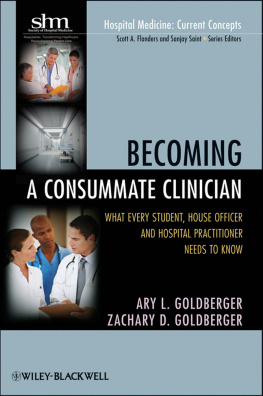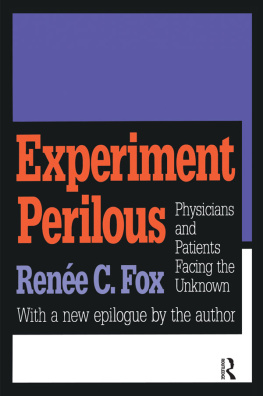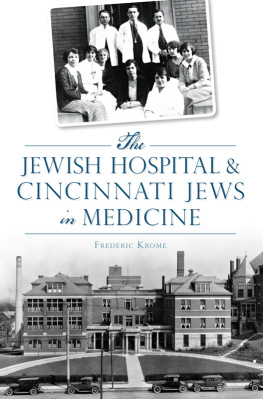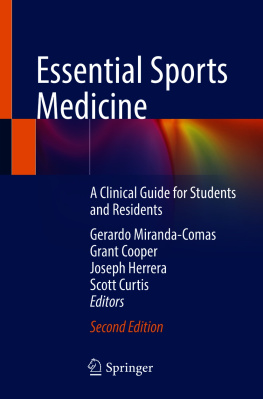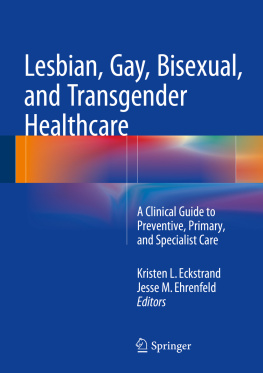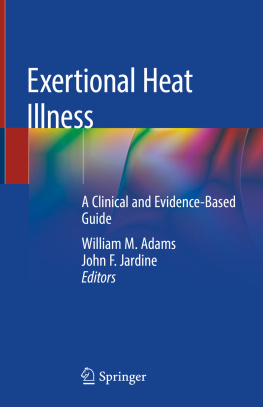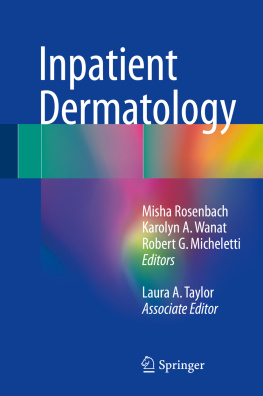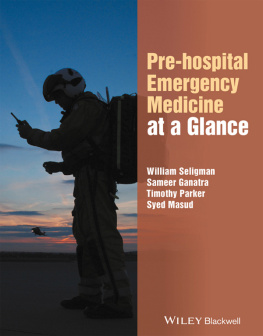
Hospital Medicine: Current Concepts
Scott A. Flanders and Sanjay Saint, Series Editors
Inpatient Anticoagulation
Margaret C. Fang, Editor
Hospital Images: A Clinical Atlas
Paul B. Aronowitz, Editor
Becoming a Consummate Clinician: What Every Student, House Officer, and Hospital Practitioner Needs to Know
Ary L. Goldberger and Zachary D. Goldberger
Inpatient Perioperative Medicine Medical Consultation: Co-Management and Practice Management
Amir K. Jaffer and Paul J. Grant, Editors
Forthcoming:
Inpatient Cardiovascular Medicine
Brahmajee K. Nallamothu and Timir S. Baman, Editors
Cover image: iStockphoto
Cover design: Michael Rutkowski
Copyright 2012 by Wiley-Blackwell. All rights reserved.
Published by John Wiley & Sons, Inc., Hoboken, New Jersey
Published simultaneously in Canada
No part of this publication may be reproduced, stored in a retrieval system, or transmitted in any form or by any means, electronic, mechanical, photocopying, recording, scanning, or otherwise, except as permitted under Section 107 or 108 of the 1976 United States Copyright Act, without either the prior written permission of the Publisher, or authorization through payment of the appropriate per-copy fee to the Copyright Clearance Center, Inc., 222 Rosewood Drive, Danvers, MA 01923, (978) 750-8400, fax (978) 750-4470, or on the web at www.copyright.com. Requests to the Publisher for permission should be addressed to the Permissions Department, John Wiley & Sons, Inc., 111 River Street, Hoboken, NJ 07030, (201) 748-6011, fax (201) 748-6008, or online at http://www.wiley.com/go/permissions.
Limit of Liability/Disclaimer of Warranty: While the publisher and author have used their best efforts in preparing this book, they make no representations or warranties with respect to the accuracy or completeness of the contents of this book and specifically disclaim any implied warranties of merchantability or fitness for a particular purpose. No warranty may be created or extended by sales representatives or written sales materials. The advice and strategies contained herein may not be suitable for your situation. You should consult with a professional where appropriate. Neither the publisher nor author shall be liable for any loss of profit or any other commercial damages, including but not limited to special, incidental, consequential, or other damages.
For general information on our other products and services or for technical support, please contact our Customer Care Department within the United States at (800) 762-2974, outside the United States at (317) 572-3993 or fax (317) 572-4002.
Wiley also publishes its books in a variety of electronic formats. Some content that appears in print may not be available in electronic formats. For more information about Wiley products, visit our web site at www.wiley.com.
Library of Congress Cataloging-in-Publication Data:
Goldberger, Ary Louis, 1949
Becoming a consummate clinician : what every student, house officer, and hospital practitioner needs to know / Ary L. Goldberger, Zachary D. Goldberger.
p. ; cm. (Hospital medicine: current concept ; 3)
ISBN 978-1-118-01143-0 (pbk.)
I. Goldberger, Zachary D. II. Title. III. Series: Hospital medicine, current concepts ; 3. [DNLM: 1. Clinical Medicine. 2. Evidence-Based Medicine. 3. Interprofessional Relations. 4. Medical Errorsprevention & control. 5. Teaching Roundsmethods. WB 102]
610.73dc23
2012023634
For
Erin, Ellen, and Nicki
Annabel, Tabitha, and Quinn
and for Lexy
PREFACE
Youve had the usual busy day. Just finished seeing and writing up the last of six patients admitted overnight to your service (including one who had to be transferred to the ICU with sepsis). Sent in an application to the medical centers curriculum committee for a proposed new course, The Golden Glove: Defining, Detecting, and Eradicating Medical Errors. Late for a hospital committee meeting on the new quality initiative to improve care in postoperative patients.
When you return to your office, two of the 59 new e-mails in your inbox catch your eye. The first is from a third-year medical student who presents with the complaint that I feel disoriented and confused only one day after starting my medical clerkship. This note is not a request for a neurological consult but, rather, a distress signal from one of your mentees who has been touching base with you throughout her clinical years without any indication of prior problems.
The second e-mail, from a friend and colleague, says: Work and teaching rounds took four hours today! How can we teach students and house officers to present more clearly and concisely and how to frame a differential diagnosis?
This book is written for hyper-busy clinicians/teachers and their trainees who face these types of challenges related to apparent gaps between the world of the class and the world of the wards. Despite the best-intended efforts of courses with names such as The DoctorPatient Encounter, students and their preceptors often express the sense that essential but hard-to-identify components are missing from our training efforts. These missing links contribute to the types of frustrations voiced above. We have adopted the term interstitial curriculum as a way of defining selected necessary concepts and practices that seem to fall between the disciplinary cracks of contemporary medical education programs.
Throughout the book, we highlight these concepts with mini-case examples. Most are drawn from internal medicine; further, a cardiovascular bias will unmask the specialty orientation of the authors, but hopefully will not prove limiting.
The complementary processes of constantly rethinking assumptions, researching information, and reformulating basic mechanisms are fundamental to practicing all types of medicine successfully. Such processes also help to avoid potentially lethal errors and help to rigorously and compassionately advance the inseparable sciences of prevention and healing. These deep and multidimensional challenges are central to the ongoing pursuit of becoming the consummate clinician.
ARY L. GOLDBERGER
ZACHARY D. GOLDBERGER
ACKNOWLEDGMENTS
We wish to acknowledge our many students, colleagues, and patients over the years, and the many others who inspired this short book. Finding oneself adrift in a turbulent clinical sea midway through medical school is, to say the least, daunting. Finding others with similar questions and existential anxieties is therapeutic, but what we really want are the keys to the kingdom where medical house staff and residents seem to speak that mysterious dialect of clinicalese with high fluency, and possess apparently uncanny reasoning and communication skills. Having read the same textbooks, taken similar preclinical lectures, and passed similar exams, we wondered whether we had all inadvertently missed some extracurricular but essential mentoring sessions somewhere along the way. Could this bridging knowledge be restored?
The discovery that the classroom-to-clinic gap was more the rule than the exception became a prime motivator for writing the book. Many people played important roles, including students at Yale School of Medicine, University of CaliforniaSan Diego, University of Washington, Harvard Medical School, and University of Michigan.
A number of colleagues have read sections and have offered important critical reviews. Among those are our wives, Erin Fouch, M.D., and Ellen Goldberger, J.D., and colleagues, Tom Delbanco, M.D., Richard Schwartzstein, M.D., Vikas Sukhatme, M.D., Ph.D., Michael Volk, M.D., M.S., Colin R. Cooke, M.D., M.Sc., and Madalena Costa, Ph.D.
Next page
